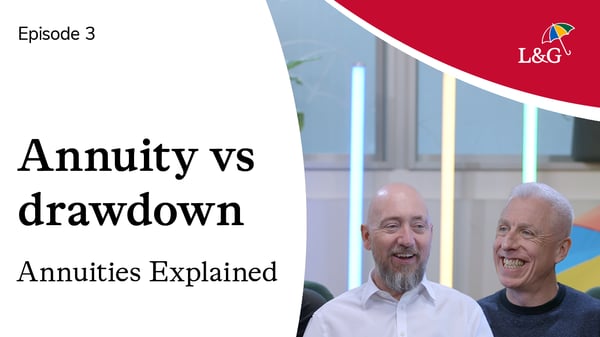Annuity vs drawdown – what's the difference?
Annuities and drawdown are the two main ways of funding your retirement using your pension pot. Depending on what you need and how your finances are looking, you might choose either a pension annuity or pension drawdown, or a blend of both.
This article explains:
- The differences between them
- Their pros and cons
- How to find out more


Barry: Hi, John. I've got a much better understanding of what annuities are now. Which has been really, really helpful, but I understand there were different retirement income options now. And there's a difference between an annuity on one side and a drawdown on another. So can you help me understand what those are?
John: Yes. I'll probably start by telling you what both of them offer you to begin with. So both of them offer you a chance to take 25% of your pension pot, so a quarter of your pension pot, as a tax-free lump sum. So you can take that out without paying any tax on it to begin with. And then that's then the difference starts, so annuity as we've discussed between us before is the product that guarantees your income for life.
John: And it pays out in the way that you've chosen to pay out. And that's absolutely set in stone, it can't change. Drawdown on the other hand, is where your money will remain invested so it can increase in value, but can also decrease in value as the stock markets or wherever you have your money invested, changes. And what that means is that your income can change as well. So you might be able to take more income, or you might have to take less income in the long run.
Barry: Well tax-free sounds great. Love that. Stock market, I'm not so sure. So I mean, this might be an unfair question John, but which one's better?
John: It's horses for courses, Barry, there's no one answer to that, unfortunately. So each person will have their own needs and their own aims that they have in retirement. But there are certain similarities between them both, it's probably worth knowing. So as we've mentioned, you can take 25% or a quarter of the pot as a tax-free income. You can't access it until 55, age 55, but that's going up to age 57 from April 2028.
John: Okay. So that's across both products as well. And the income that you get from these products is subject to tax. So you will pay income tax on the income that you take from it. Okay. There is one other thing Barry. This doesn't have to be an either or option. So it's not drawdown or annuity. They do complement each other well and can work together quite well. So to give you an example, you might take out a guaranteed income that can help towards your bills that you have to pay on a regular basis. And that could then leave some money left over to use in drawdown to invest and maybe get a better income as a result of that.
Barry: Well that sounds really sensible. I like choice. Can you help me understand the pros and cons in a little bit more detail?
John: Okay Barry, if you value security and reliability, annuity could be an option to consider. It provides that guarantee of what you're going to get and also, the amount of income that you receive can be dependent on your health and your lifestyle. So if you're unwell or have certain lifestyle factors like smoking, you can get a higher income as a result of that. But on the flip side, if you were to die shortly after taking one out, you might not get back all the money that you've invested in there. Further, if you consider, flexibility as being your main driver, then maybe drawdown is the right option to take. It allows you to remain invested so you can maybe get a better income from it, but also your value of your investment could go down as well. You can, unlike annuity, you can change the level of income that you receive from it as time goes on. So you can flex it to your needs.
Barry: So it's almost security versus flexibility in deciding what's most important to me?
John: That's right. So, how do I make the best choice for my retirement income then John? So it's important to carry on reviewing your options Barry. And one way you can do that is to use the government's Pension Wise service. And they can give you free, unbiased guidance on what your options are help you see a clear path on that. Or if you're still confused, then there's financial advisors that you can use as well to get some professional advice on what's best for you. And on our website, we have our retirement income calculator that gives you a really good view of the income that you can get from an annuity, from drawdown, and from other products as well. So you can see those side by side and get a view there.
Barry: So John, I've spent a great deal of my life working really hard, saving into my pension, building up this money whilst trying to do all the fun things in life, too - but I'm really conscious that when I retire, I've got no plans on working again. I don't want a part time job, don't want any of that. And I'm a bit concerned to put my money at risk. You mentioned the word investment and flexibility, but I'm concerned to put my money at risk then as I don't want to lose it because I've got no capacity to earn anymore. So what's your thoughts on that?
John: Well firstly, hats off to you for saving all that money over the years and getting yourself in a good position now to be able to make some wise decisions. You say that you concerned about that risk and with the obvious options you can look at, it's then the products that don't have any risk with them, such as an annuity, whether that be the lifetime annuity that we've discussed that will take you, pay you an income for the whole of your life, or whether it's a fixed term one that will pay you for a certain amount of time. But I think you should also consider that risk is variable. There isn't just one type of risk, there's low risk, there's medium risk, there's high risk. Okay. And when you're looking at more risky products like drawdown, there can be options available to suit your level of risk as well. Now, this can get quite complex.
John: And you're probably wise to go and talk to a financial advisor to understand your risk levels and what products would suit those. But, if you want to remove all risk from your retirement planning, then, guaranteed products like annuities can do that.
Barry: Okay, so I guess I've got that balance between hearing those words like stock market and going right that means big risk. And then going, well, what if an annuity doesn't provide me with enough income? But I want that that level of lower risk that goes with it. So can I have a combination of the two that isn't all going into the stock market?
John: You can, and again speaking to financial advisor is what you want to do here. But there are investments that are low risk, for investing things like bonds and deposits where there's minimal risk in that. But there will always be an element of risk within the drawdown products.
Barry: Okay, and I've just got to balance that up against what the future that I might like and for how long I want to live? The value of advice could be really imperative there.
John: I think it is in this instance, Barry. I should also point out Barry that Legal & General have a retirement advice service that you can use to help you understand your options better at retirement. So that might be worth looking into.
Barry: That's really helpful, John. I'll certainly have a look at that, take some time. You've been a font of knowledge today. Once again, thank you so much, John.
John: You're really welcome, Barry. Thank you. Visit legalandgeneral.com/annuities for information and helpful guides. And also if you liked the video remember to like, share and subscribe.
What's the difference between an annuity and drawdown?
When you retire, you need to decide what to do with the money you’ve saved into your pension to provide you with an income through your retirement years. Annuities and drawdown are two of the most common ways of taking a regular income.
You can use money from your pension pot to buy an annuity.
- A pension annuity is a product that pays you a regular guaranteed income for the rest of your life, no matter how long you live. One option is to convert the pension pot you’ve built up into a regular income. You can do this by buying what’s called a pension annuity, lifetime annuity or simply an ‘annuity’ with some or all of the money in your pension pot. With a pension annuity you’ll know exactly how much you’re getting, come rain or shine.
- Once you’ve set up your annuity you can’t make any changes to it. So it’s important to shop around and find the one offering the best annuity rate and product options for you.
You can move some or all of your pension pot money into drawdown.
- Putting your pension pot into drawdown means you leave your money invested for you to take out (or ‘draw it down’) as and when needed. The money left invested could grow to replace some or all of the money you draw down, though its value could also drop.
- Drawdown is much more flexible than an annuity. You can change how much and when you take money out of it, and how any money you don’t take out is invested. But you could run out of money because, unlike with an annuity, your payments are not guaranteed.
Which is better – annuity or drawdown?
That depends on what’s most important to you. As a rule, people choose drawdown products for their flexibility and annuities for their predictability. And it doesn’t have to be an either/or pension drawdown vs annuity choice. More and more people are using both together.
For example, when you retire you might want to guarantee that you can always cover your bills. So you spend some of your pot on an annuity, which gives you a guaranteed income for life. Then you can invest the rest of it however you’d like.
Pros and cons of annuities vs drawdown
So what is the difference between annuity and income drawdown? And is there anything about them both that’s the same? We’ve put this annuity vs income drawdown chart together to show you. To make it simple, we've compared a lifetime annuity with drawdown, but if you want to weigh up a fixed term annuity vs drawdown we have a separate article on fixed term annuities.
The differences
| Annuity | Drawdown |
|
The amount you’ll get is guaranteed You pay your provider a fixed amount to buy your annuity. They will then make guaranteed payments to you for the rest of your life or an agreed period. |
The amount you’ll get is not guaranteed The value of your pension pot can go down as well as up. That can affect the amount you can draw down from it. But your payments aren’t fixed – you can choose how much income you want to take, and when. |
|
An annuity is a lower risk product Once you buy an annuity, your income is guaranteed. It will never unexpectedly stop or run out. |
Drawdown can be a risky product It’s dependent on your pension pot, which could lose value or even run out. |
|
Your pension pot can’t grow any more You use your pot to buy your annuity. Once it’s spent, it can’t go up or down in value, unless you have selected an increasing option. |
Your pension pot could still grow Any money you don’t draw down stays invested. Its value can still grow, though it could also go down. |
|
Once agreed, you have no flexibility Your pension annuity can’t be cashed in or surrendered. You can’t make any changes once it’s up and running. |
Once agreed, you have some flexibility You can draw down as much money as you want, stopping and starting whenever you want to. You can buy a pension annuity at any future point. |
|
Your health and lifestyle matter If you’re not in good health, or make certain lifestyle choices, providers may offer you a higher income - this is an enhanced annuity. |
Your health and lifestyle don’t matter Your age and lifestyle make no difference to the amount you might get from a drawdown. |
|
There are no ongoing costs Once your annuity’s up and running, you don’t need to pay any fees or charges. |
There are ongoing costs Your provider will charge you a fee for your drawdown account.
|
The similarities
|
For annuities and drawdown |
|
You must be aged at least 55 (or 57 after April 2028). |
|
You can usually take up to 25% of your pension pot as a tax-free lump sum. |
|
Any income you take is taxable Income above your personal allowance is taxable. The amount of tax you pay on your annuity or drawdown income will depend on your circumstances. |
|
Your state benefits could be affected Annuity or drawdown income could affect your entitlement to any means-tested state benefits. |
|
Your loved ones might inherit some money You can name a loved one as a beneficiary, so they receive money after you die. |
What should I do next?
So are annuities worth it? Or is pension drawdown better than an annuity? Or maybe both? Well, that depends on your financial goals and circumstances. If you’re still not sure, we’d recommend:
- Getting some financial advice or guidance:
- if you don’t already have a financial adviser, you can find one at Unbiased
- if you’re over 50, book a free appointment with Pension Wise for impartial guidance
55% of over-55s who have accessed a pension chose to seek advice from a regulated adviser or guidance from the free, government-backed service, Pension Wise. One in five of the 45% who didn’t get guidance now regret their decision.
Related articles

What is an annuity?

What is pension drawdown?
